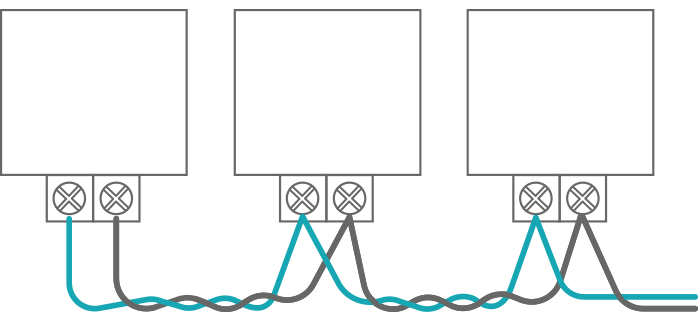BACnet (Building Automation and Control Network) is a communication protocol widely used for HVAC, lighting, energy management, security, fire detection, as well as other building automation systems (BAS). It establishes a standard that allows different devices to communicate and operate together, even across different networks. This article introduces the two most popular BACnet protocols, BACnet/IP and BACnet MS/TP, explores their differences and advantages and discusses how to choose the best option for different use cases.
The Fundamentals of BACnet
In order to standardize the device communication process, the BACnet protocol is divided into objects, services, and transport systems to allow interoperability between different manufacturers. In real world components these devices can be a sensor, controller, meter, RTU, or PLC.
The object model individual devices in an automation system covers the device data and behaviour. Services are requests that one device sends to another. These services transfer between devices as encoded messages delivered through the transport system. This process resembles a postal system in real life, where objects are letters that contain important information, services act as postal offices receiving and processing packages, and transport systems are the delivery infrastructure, ensuring the letters are delivered safely.
The BACnet protocol operates on several different communication standards, including Ethernet, ARCNET, Point-to-Point, and Zigbee, with BACnet/IP and BACnet MS/TP being the two most popular options.
BACnet/IP operates over Ethernet and IP, assigning each device a unique IP address for message exchange using UDP packets. Routers can be used to manage traffic between sub-networks and even non-IP networks, facilitating communication across devices. To handle BACnet messages across multiple IP subnets, a BACnet Broadcast Management Device (BBMD) is required.
BACnet MS/TP uses a single serial cable in a daisy-chain configuration. It utilizes a Master-Slave Token Passing system, where only the Master device holding the token can initiate communication, while the others Slave devices listen. This method ensures orderly data transmission, prevents collisions, and allows each device a chance to communicate.
Comparing Physical Interfaces: Ethernet vs. RS485
BACnet/IP and BACnet MS/TP can be compared based on their unique physical communication interfaces: Ethernet and RS485.
Ethernet is widely adopted across various sectors, from IT infrastructure to industrial equipment, as a result of its higher bandwidth and data rates ranging from 10 Mbps to 10 Gbps. In contrast, RS485 operates with a data rate, between 9.6 kbps and 115 kbps. By utilizing Ethernet technology it offers enhanced flexibility and scalability, allowing for wireless connections across diverse network topologies, while RS485 is typically limited to few configurations such as a daisy-chain twisted pair connection.
Nevertheless, RS485 still remains the preferred choice for many industrial devices by offering several crucial advantages that make it irreplaceable in the industry. One key advantage of RS485 is its Master-Slave architecture, which eliminates data packet collisions by allowing only one Master device to send data at any time.
While RS-485 operates at lower data rates but still meets the requirements for most industrial applications like process control and automation. Operating at reduced speed also enhances resilience against noise and signal disruptions, as lower frequencies are less susceptible to electromagnetic interference from nearby equipment. This makes RS-485 ideal for demanding industrial environments.
Comparing Network Topologies
BACnet/IP brings a great deal of flexibility due to the Ethernet interface, allowing devices to be connected in various network topologies, as shown in the diagram below:
Each topology offers unique benefits. For example, in a star topology, every device connects to a central node, which guarantees network reliability as long as the central node operates normally. The ring topology organizes devices in a circular formation, sending data in one or both directions. Bidirectional configurations increase reliability by enabling data to reroute if one device malfunctions. Many networks utilize a mix of different topologies to achieve a balance between reliability and cost efficiency.

As for BACnet MS/TP, the most common connection method is the daisy-chain bus configuration, where all the devices in the network are connected in a linear chain using a single RS485 cable. This configuration is often used for PLCs (Programmable Logic Controllers), RTUs (Remote Terminal Units), as well as metering devices due to its simplicity. Theoretically, this architecture can support up to 128 devices. However, in practice, it typically supports around 100 devices due to reserved addresses.
Comparing Security Features
BACnet/IP operates over the IP standard and can utilize modern security infrastructures such as firewalls and Virtual Private Networks (VPNs). When integrated with the BACnet Secure Connect (BACnet/SC), an extra encryption and authentication layer can be added to enhance the overall security of the network. BACnet/SC employs Transport Layer Security (TLS) to ensure secure communications, making it adaptable to various network configurations, including cloud-based and on-premises systems.
In contrast, BACnet MS/TP is primarily utilized for on-premises systems, making it especially relevant for building automation systems and facilities where local management of devices is crucial. BACnet MS/TP is inherently localized, which significantly enhances security measures because it eliminates the possibility of remote access to the network. This means that any attempts to intercept or capture data would require physical presence, making unauthorized access much more challenging.
Comparing Installation, Troubleshooting and Cost
BACnet MS/TP is a more straightforward when it comes to implementation, due to its reliance on less complex wiring schemes. This simplicity not only makes BACnet MS/TP more cost-effective to install compared to BACnet/IP but also allows for easier integration within existing systems.
On the other hand, BACnet/IP requires a greater level of expertise in information technology due to its dependence on advanced network features and configurations. Setting up BACnet/IP typically requires various devices to implement different network topologies, which can complicate the installation process.
When network errors arise, troubleshooting BACnet/IP systems also requires more professional skills, because the structure of IP networks is typically more complex. However, it's important to note that IP networks come with more advanced diagnostic tools and network management software that can help address these issues.
BACnet MS/TP systems, due to their simple network configurations, are generally easier to troubleshoot. Maintenance personnel can identify and rectify problems more quickly due to these straightforward architectures, even without sophisticated diagnostic tools.
How to Choose the Right Protocol
Overall, BACnet MS/TP is more suitable for systems on a smaller scale, where cost is a crucial factor and high-speed communication is not as important. The RS485 wiring is simpler to implement, with lower infrastructure costs, but limited in terms of scalability and speed compared to BACnet/IP.
BACnet/IP is better suited for large, complex building automation projects that require high-performance communication and the ability to connect multiple buildings over multiple subnetworks.
Accuenergy manufactures various energy meters that support both BACnet/IP and BACnet MS/TP protocols. Acuvim II is an advanced multi-function power & energy meter that comes with revenue-grade accuracy and power quality monitoring capabilities. The meter alone supports the BACnet MS/TP protocol, but can be expanded to support BACnet/IP as well with AXM WEB2 modules.
 X
X 
 X
X  X
X  X
X